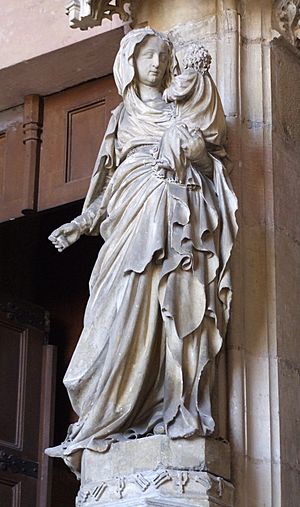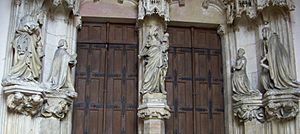Jean de Marville facts for kids
Jean de Marville (died July 1389) was a talented sculptor who lived a long time ago, in the 1300s. He is famous for his amazing work at a special monastery called Champmol in Burgundy, France. He worked for Philip the Bold, who was the Duke of Burgundy. During this time, Burgundy became a very important place for art and culture in Europe.
Who Was Jean de Marville?
Jean de Marville likely came from a town called Marville in northern France. He spent most of his working life in Burgundy. Some people think he might have been from Flanders (a region that is now part of Belgium). He was also known by other names like Hennequin de Marville or Jehan de Marville.
We know that a sculptor named Jean de Menreville worked on the church of Saint-Pierre in Lille in 1366. Many believe this was the same Jean de Marville who later worked on the tomb of Philip the Bold. In 1369, he helped decorate a chapel in Rouen Cathedral for King Charles V of France.
Jean de Marville started working for Duke Philip the Bold on January 22, 1372. He was called an ymagier, which means a sculptor or image-maker, and also a valet de chambre, a personal attendant to the Duke. The next year, he moved to Dijon because the Duke asked him to.
In 1377, records show that ivory was bought for "Mainreville, tailleur de menues oeuvres" (a carver of small works). Because of this, a small ivory statue of the Trinity (God the Father, Son, and Holy Spirit) in the Museum of Fine Arts, Houston might have been made by him.
Jean de Marville was a very important artist who started his own school of sculpture. His most famous student was Claus Sluter. Sluter's nephew, Claus de Werve, also learned from this school. Other sculptors who were part of this group included Jehan de la Huerta and Antoine le Moiturier.
Claus Sluter (who lived from about 1360 to 1405) was a sculptor from Haarlem in the Netherlands. He joined Jean de Marville's workshop in 1383. At that time, de Marville was in charge of building and decorating the Chartreuse of Champmol. This monastery was planned to be the Duke's burial place. The beautiful sculpture of the Virgin Mary and child at the center of the monastery's chapel is thought to be the work of either Marville or Sluter.
Philip the Bold's Tomb
On March 29, 1381, Duke Philip the Bold asked Marville to create a special tomb for him out of alabaster (a soft, white stone) in Dijon. The work on this important project began in October 1384.
When Jean de Marville passed away in 1389, Claus Sluter took over his role as the main sculptor (ymagier). The tomb was not finished until 1404, so it seems that Sluter did most of the work, or at least guided the project.
This tomb is quite special because it has many separate statues of monks, priests, and ordinary people, instead of the usual flat carvings. This idea might have come from Marville, or it could have been a new idea that Sluter introduced when he took charge of finishing the tomb.
See also
 In Spanish: Jean de Marville para niños
In Spanish: Jean de Marville para niños



